Hyundai Elantra: Maintenance / Fuses
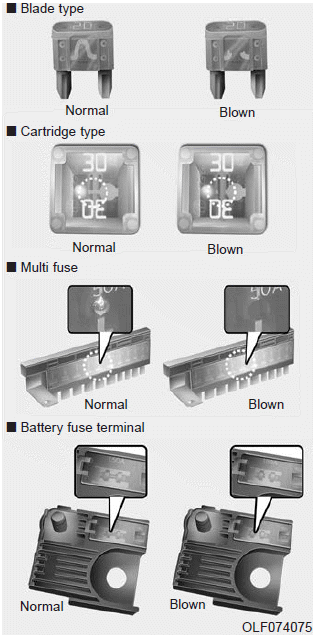
A vehicle’s electrical system is protected from electrical overload damage by fuses.
This vehicle has 2 (or 3) fuse panels, one located in the driver's side panel bolster, the other in the engine compartment near the battery.
If any of your vehicle’s lights, accessories, or controls do not work, check the appropriate circuit fuse. If a fuse has blown, the element inside the fuse will be melted or broken.
If the electrical system does not work, first check the driver's side fuse panel. Before replacing a blown fuse, turn the engine and all switches off, and then disconnect the negative battery cable. Always replace a blown fuse with one of the same rating.
If the replacement fuse blows, this indicates an electrical problem. Avoid using the system involved and immediately consult an authorized HYUNDAI dealer.
Information
Four kinds of fuses are used : blade type for lower amperage rating, cartridge type/Multi fuse/Battery fuse terminal for higher amperage ratings.
WARNING
NEVER replace a fuse with anything but another fuse of the same rating.
- A higher capacity fuse could cause damage and possibly cause a fire.
- Do not install a wire or aluminum foil instead of the proper fuse - even as a temporary repair. It may cause extensive wiring damage and possibly a fire.
NOTICE
Do not use a screwdriver or any other metal object to remove fuses because it may cause a short circuit and damage the system.
Instrument Panel Fuse Replacement
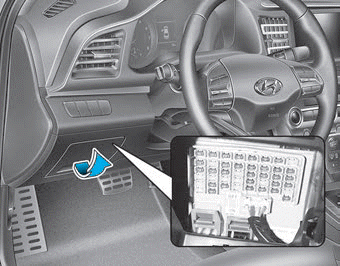
1. Turn the engine off.
2. Turn all other switches OFF.
3. Open the fuse panel cover.
4. Refer to the label on the inside of the fuse panel cover to locate the suspected fuse location.
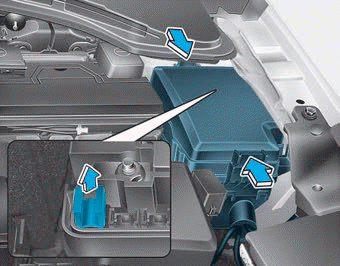
5. Pull the suspected fuse straight out. Use the removal tool provided in the engine compartment fuse panel.
6. Check the removed fuse; replace it if it is blown. Spare fuses are provided in the instrument panel fuse panels (or in the engine compartment fuse panel).
7. Push in a new fuse of the same rating, and make sure it fits tightly in the clips. If it fits loosely, consult an authorized HYUNDAI dealer. In an emergency, if you do not have a spare fuse, use a fuse of the same rating from a circuit you may not need for operating the vehicle.
If the headlamps or other electrical components do not work and the fuses are OK, check the fuse panel in the engine compartment. If a fuse is blown, it must be replaced with the same rating.
Fuse switch
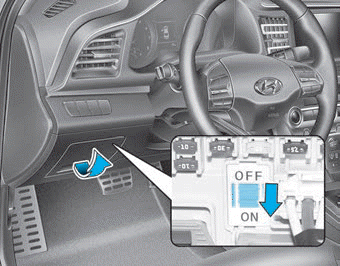
Always, place the fuse switch to the ON position.
If you move the switch to the OFF position, some items such as the audio system and digital clock must be reset and the smart key may not work properly.
Information
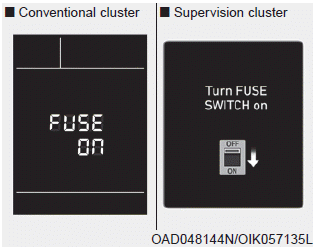
If the fuse switch is OFF, the above message will appear.
NOTICE
- Always place the fuse switch in the ON position while driving the vehicle.
- Do not move the fuse switch repeatedly. The fuse switch may be damaged.
Engine Compartment Panel Fuse Replacement
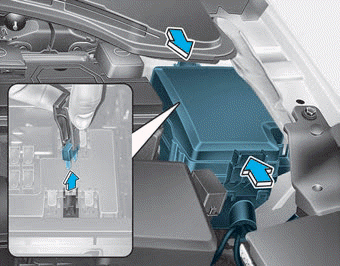
â– Blade type fuse
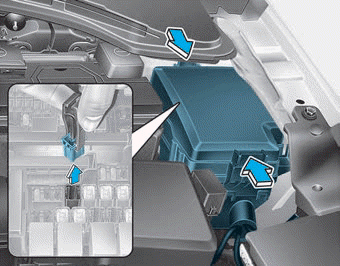
â– Cartridge type fuse
1. Turn the engine off.
2. Turn all other switches OFF.
3. Remove the fuse panel cover by pressing the tap and pulling up.
4. Check the removed fuse; replace it if it is blown. To remove or insert the fuse, use the fuse puller in the engine compartment fuse panel.
5. Push in a new fuse of the same rating, and make sure it fits tightly in the clips. If it fits loosely, consult an authorized HYUNDAI dealer.
CAUTION
After checking the fuse box in the engine compartment securely close the fuse box cover inside the engine compartment, until it clicks.
If the fuse box is not closed properly, water may leak in side, possibly causing a malfunction with the electrical system.
Main fuse
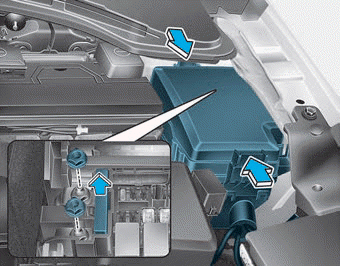
If the main fuse is blown, it must be removed as follows:
1. Turn off the engine.
2. Disconnect the negative battery cable.
3. Remove the fuse panel cover by pressing the tab and pulling it up.
4. Remove the nuts shown in the picture above.
5. Replace the fuse with a new one of the same rating.
6. Reinstall in the reverse order of removal.
Information
If the main fuse is blown, consult an authorized HYUNDAI dealer.
Multi fuse
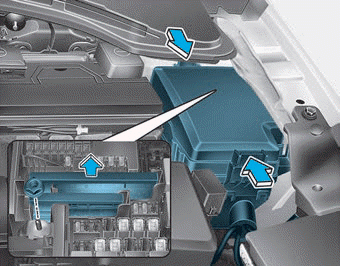
If the multi fuse is blown, it must be removed as follows:
1. Turn off the engine.
2. Disconnect the negative battery cable.
3. Remove the fuse panel cover by pressing the tab and pulling it up.
4. Remove the nuts shown in the picture above.
5. Replace the fuse with a new one of the same rating.
6. Reinstall in the reverse order of removal.
Information
If the multi fuse is blown, consult an authorized HYUNDAI dealer.
Fuse/Relay Panel Description
Instrument panel fuse panel
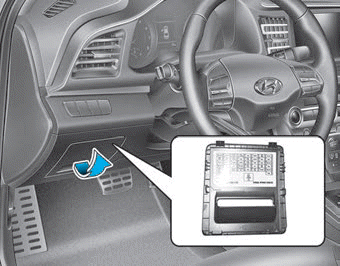
Inside the fuse/relay box cover, you can find the fuse/relay label describing fuse/relay name and capacity.
Information
Not all fuse panel descriptions in this manual may be applicable to your vehicle; the information is accurate at the time of printing. When you inspect the fuse box on your vehicle, refer to the fuse box label.
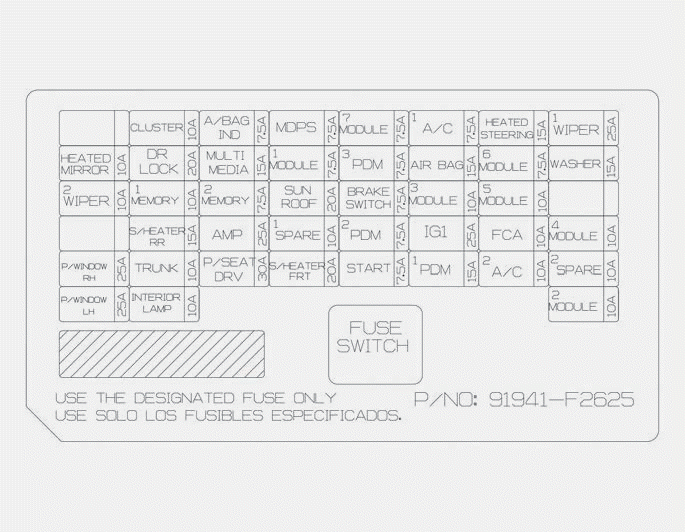
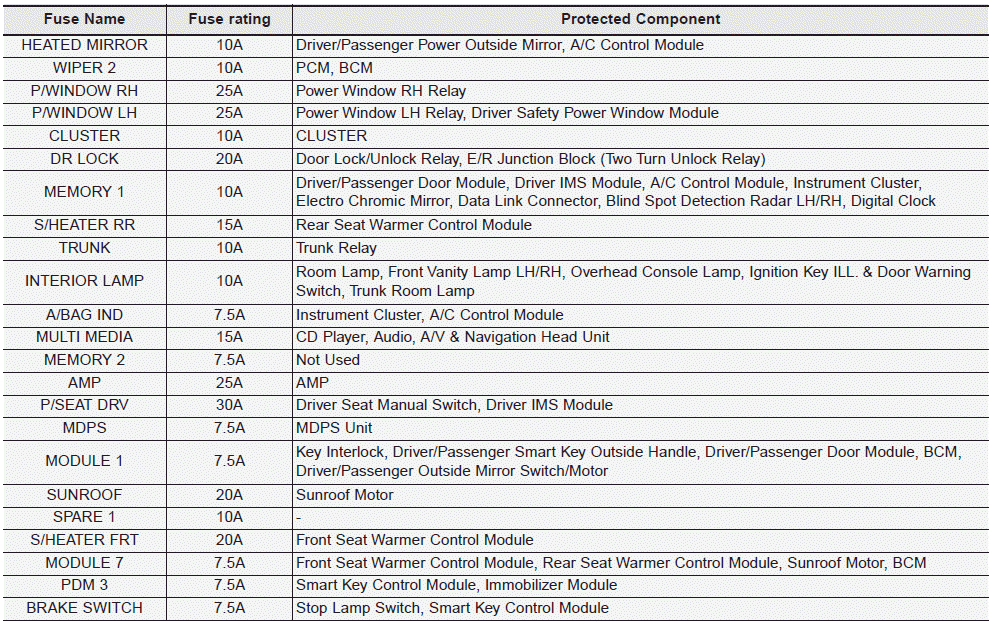

Engine compartment fuse panel

Inside the fuse/relay box cover, you can find the fuse/relay label describing fuse/ relay name and capacity.
Information
Not all fuse panel descriptions in this manual may be applicable to your vehicle; the information is accurate at the time of printing. When you inspect the fuse panel in your vehicle, refer to the fuse panel label.
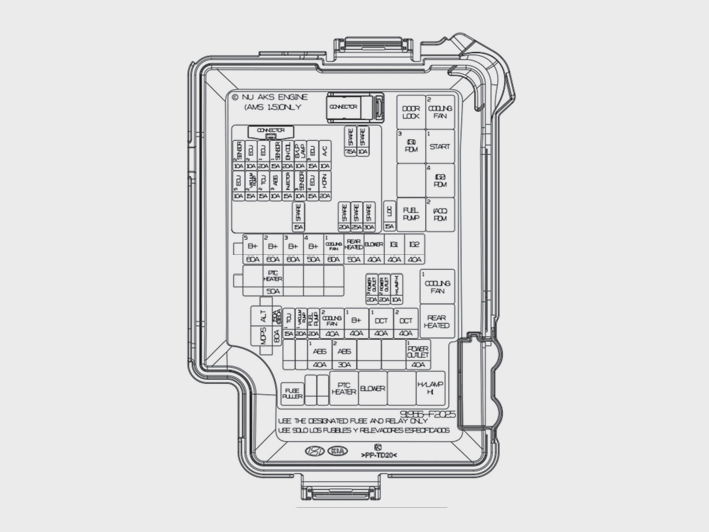
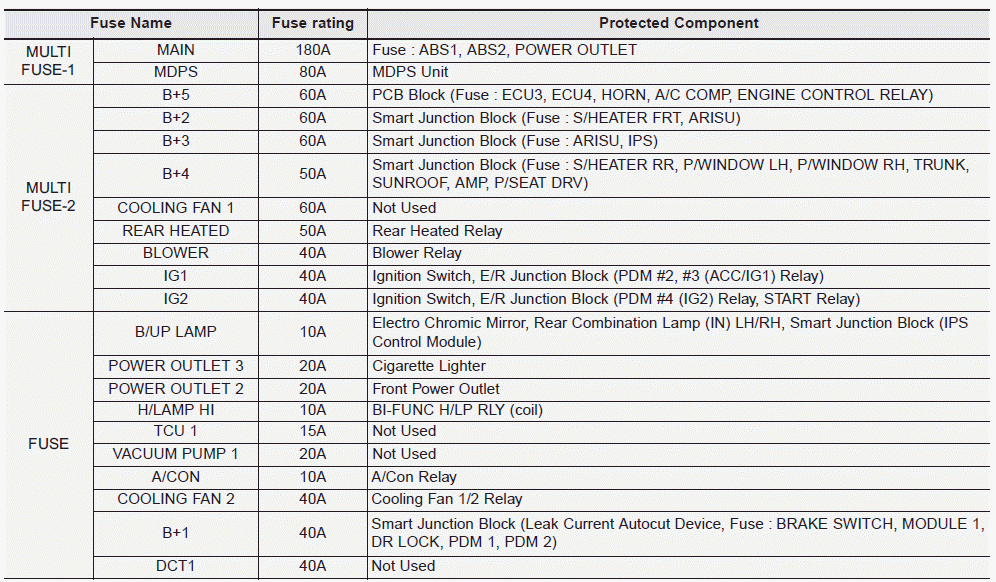

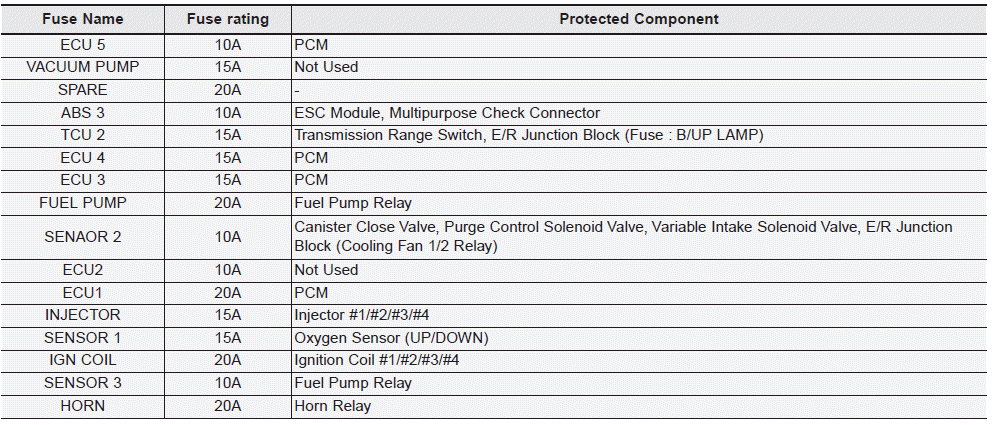
 Low Aspect Ratio Tires
Low Aspect Ratio Tires
Low aspect ratio tires, the aspect ratio is lower than 50, are provided for sporty
looks.
Because low aspect ratio tires are optimized for handling and braking, their
sidewall is a little stiffer ...
Other information:
Hyundai Elantra AD (2016-2020) Service Manual: Input Speed Sensor Description and Operation
Description
Input speed sensor is a vital unit that measures the rate of
rotation of the input shaft inside the transaxle and delivers the
readings to the TCM. The sensor provides critical input data that's used
in feedback control, damper clutch control, gear setting control, line
pressu ...
Hyundai Elantra AD (2016-2020) Service Manual: Engine Control Module (ECM) Repair procedures
Removal
•
When replacing the ECM, the vehicle equipped withthe immobilizer must be performed procedure asbelow.
[In the case of installing used ECM]
1) Perform "ECM Neutral mode" procedure with GDS.
(Refer to Body Electrical System - "Immobilizer System")
2) After ...
